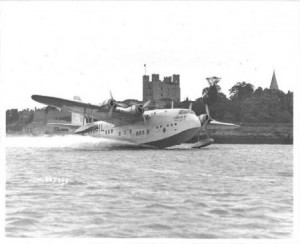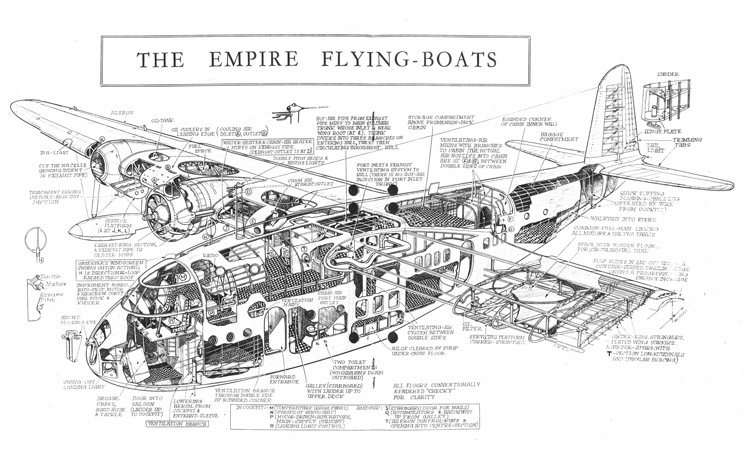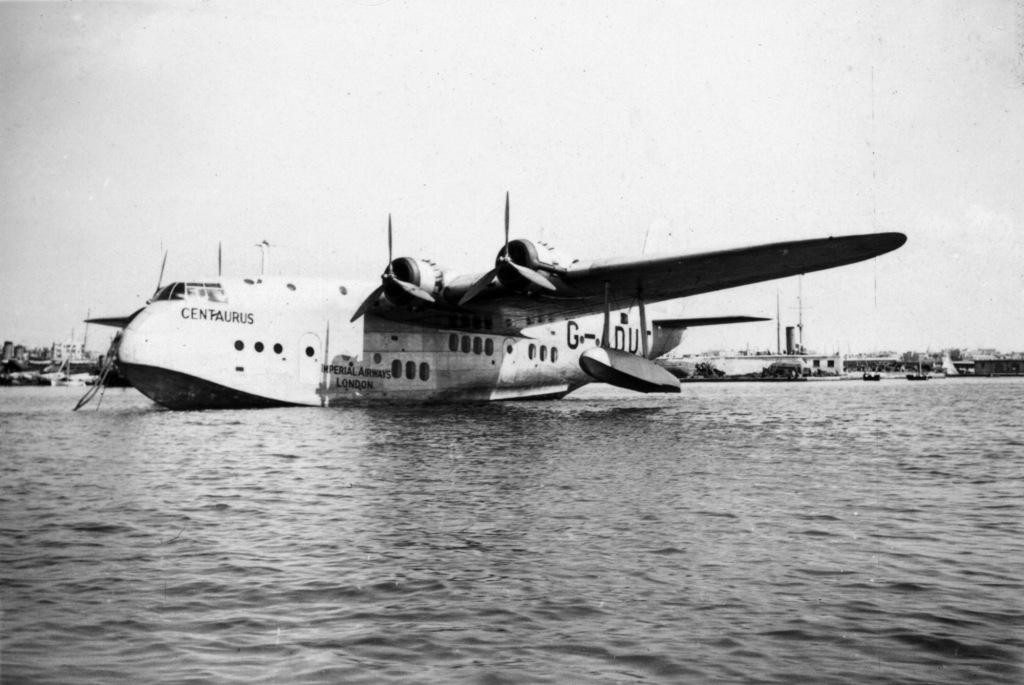Running through ideas for more voice recordings, I thought the description of the acceptance testing would be of interest.

The first three Empire Flying Boats
Only one flying boat had been through the acceptance testing and flown – Canopus ADHL, in the summer of 1936.
The second off the production line was crated up and shipped to the USA. I don’t know whether this meant it had been through acceptance testing or not [I guess it didn’t, which is why Centaurus got ahead in the alphabet registration]. Presumably it would have to go through them all again when it was assembled on the other side of the Atlantic. Geoffrey mentions this, talking about ‘difficult attitudes’ with the USA about flying the Atlantic. This may seem amazing to the modern reader, but at that time Britain and the USA were in a race for the first passenger plane to cross the Atlantic non-stop. It was Pan-Am’s Clipper versus Imperial Airways’ Empire. I think Clipper won, as Cavalier ADUU ended up doing mainly flights down the coast and the Caribbean (day trips to Cuba were very popular, as demonstrated in the musical Guys and Dolls), from its base in Bermuda (‘British’ soil).
Geoffrey was appointed to the flight testing crew for Centaurus, under Captain Egglesfield. He lists the rest of the crew: Carlos Madge, Paddy Coussans, Philips (a New Zealander) and Geoffrey. He notes elsewhere that one of the main reference books on the Flying Boats gets it wrong!
He also gives the definite pronunciation for Paddy Coussans, also written in other documents (including in Geoffrey’s handwriting) as Cousins. Paddy Coussans was radio operator for a good many years. His photo appears in the book picking up the moorings for the first flight into Butiaba, and his next ‘appearance’ is as radio officer for the ill-fated Corsair. Geoffrey’s private correspondence with journalists during his retirement indicated that Mr Coussans was pretty much hounded for the ‘real’ story behind the Corsair crash. I think the tape of that event is worth pulling out.
Acceptance testing clips
The first clip last five minutes, and is part of his introduction to the posting. He talks about his job as ‘Purser’ which was a new invention, and stocking the aircraft. His comments about bunk beds and storing them to make sure the aircraft was in trim are interesting. There is an excellent cutaway of the Empire flying boat in the Haynes guide, but it doesn’t label things. This one from the ancient website Talk Model Toys was posted by user Keith Wreyford, and I suspect the provenance is Dinky Toys. (I saw one of these Dinky Toys come up on Flog It! and I’d have paid at least that much for it).
The second clip continues immediately from the first, and unfortunately has a bit of distortion early on. I’ll try to fix that if I can. This is about the main flight tests that he remembers, and includes the comments about the previous boats and the crew which I mentioned above. That takes about 2 minutes then he’s talking about flying out of Rochester, altitude flying and landing.
That clip ends apparently in the middle of a paragraph. Maybe he overtaped it, but the third clip skips some minor diversion into the past and moves on to Centaurus’s maiden flight to Alexandria, which included diverting to Southampton to pick up the Christmas Mail. We’ll come back to the condition of the crew after the overnight stop in Greece some other time.
Geoffrey left Centaurus at Alexandria and never took a good picture of her that I could identify. I’m very grateful to Mark Postlethwaite for use of the picture of Centaurus at Alexandria some time later. The picture of Canopus at Rochester came from the web-site Air-minded.




Once again, totally enthralled to hear the recollections, spoken with so much detail and delivered so crisply. It is clear that he was at the Short Bros factory as the aircraft came off production, and the practice was (according to Brian Cassidy – author of ‘Flying Empires’ – I hope that is not the book he disliked) to flight test within a day or so of the aircraft leaving the production hangar, and within a day to have the aircraft cleared for delivery to the airline.
From my knowledge of such things – I am more ‘jet-age’ that prop-era – the so called weight and balance sheet that an airline employee, such as Geoffrey, should have been provided immediately – as it has always been an integral part of documentation which accompanied issue of the certification of airworthiness for the type and its variant.
Records to which I have access showing the production data at the Short Rochester factory record G-ADHL to G-ADUU as separated by production numbers for 107 aircraft, of which only 4 were S23: the rest were Singapore III flying-boats for the RAF, and the first prototype of the Sunderland (prod no 803) – and that alone would have had the design staff working very hard. I am sure it understates the case to claim that they were pretty busy. However, having only the ‘design’-related 2-page item listing they were using, while Geoffrey was taking an ‘operations’-related approach, which is almost a condensed version of the ‘design’ data, does suggest they were cutting some corners. No issue for me – the nation was gearing up for war, and these were the sort of things that happened.
Production data f.y.i. :
G-ADHL (prod no 705) Short S23 prototype Mk1
In build from Nov 1935 to end of June 1936. (1st flight 3 July 1936). I have always understood to have been delivered within a month to the airline for crew training and route proving, and was the first aircraft to enter service with the airline.
G-ADHM (prod no 804) Short S23 Caledonia – long-range variant (1st flt 15 Sept 1936). This was delivered and used largely for services to/from Foynes in Ireland/Botwood in Newfoundland.
G-ADUT (prod no 811) Short S23 Mk2 Centaurus. In-build from Feb 36 to Nov 36
G-ADUU (prod no 812) Short S23 Mk2 Cavalier. In-build from Feb 36 to Dec 36 – sadly the aircraft lost between New York – Bermuda (21 Jan 1939) : 3 fatalities/10 survivors
The operations section of ‘Flying Airways’ was not written by Brian Cassidy. We only ever spoke once, by telephone, and he commented that he was disappointed with that portion of the book. For info – his records new reside in the Solent Sky Museum at Southampton.
The hint of more soundtracks to come is welcome!
Mike